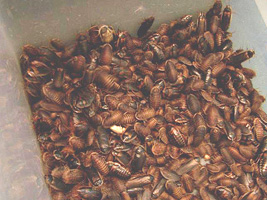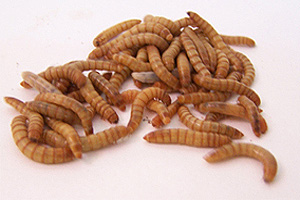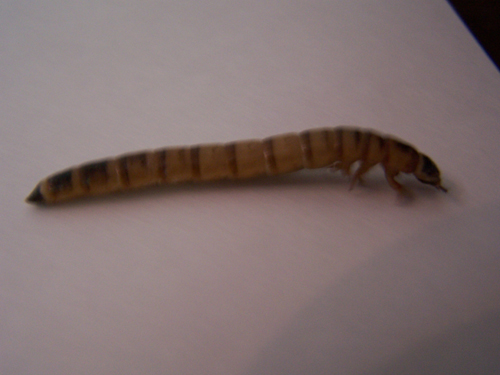|
Other Insect Care Instructions
Roaches
Unlike many other species, the roaches we sell (Blaptica Dubia) cannot climb smooth surfaces, making them ideal for feeder insects. Once established, a colony will provide you with baby roaches measuring 1/8” and adults measuring nearly 2” (and everything in between). Roaches are very prolific, are extremely healthy for your pet and don’t smell, making them an excellent feeder insect.
First get a large plastic bin. I use clear ones that measure 16”W x 24”L x 12”H. Make sure it is nice and clean before you attempt to put any roaches in it. On one half of the bin put either paper towel rolls(about 20) or 2 or 3 rows of egg cartons. Take the plastic cover and cut out all of the plastic so that you just have the rim of it. Either staple gun or glue on aluminum insect screening to this for ventilation. Then add the roaches. The bin should be kept at slightly hotter than room temp. We keep ours at 85F.
Feeding the roaches is very simple as they eat almost anything. Fresh fruits and vegetables are important. Leafy greens and fruits with high moisture content like oranges are ideal. Grains and a high quality roach gutload should also be part of their diet. They should be able to get all the moisture they need from the fruits, so there is no need for water.
Cleaning should be done on a bi-weekly basis, removing waste and any dead roaches. This insect can be used as the staple of their diet. Cup feeding this insect is the easiest way I have found.
Mealworms
Mealworms make a good alternative food source and are good for variety in diets of many reptiles and fish. They are extremely easy to care for, have a long shelf life and don’t make a mess. They are also slow moving and very cheap, making them an excellent food source.
If you plan on just using your mealworms for food, do the following:
Put the mealworms in a plastic bin and provide plenty of ventilation by poking air holes in the cover. Put about an inch of mealworm bedding in, and mix the worms into that. Place this in the refrigerator (ideal temp is 45-50F). They will last in this "hibernation state" for up to 2 weeks. Fresh potato slices or carrots should be given to them when you take them out.
If you plan on breeding them, do the following:
Put the worms and an inch of bedding into the plastic container as stated above. Place fresh potato slices or carrots slices on top. The mealworms turn into black beetles (don’t worry, they can’t climb the smooth surfaces of the plastic bin to get out), which then lay more baby mealworms. Make sure they always have fresh food and bedding.
Superworms
Superworms are an excellent food source to add variety to your pet’s diet. They come in many sizes making them an ideal feeder insect.
First, find a big plastic bin (we use 12”H x 16”W x 24”D), and make sure it is nice and clean. Fill it up about 1.5 – 2 inches with superworm bedding. Then add the worms. Keep the container at room temperature and feed them fresh greens and orange slices for moisture daily. This insect is best fed by cup feeding to reptiles.
|